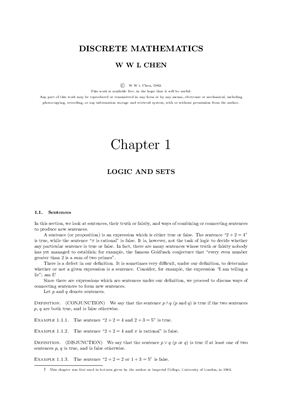Macquarie University, Siydney, 1982, -190 pp.
This set of notes has been compiled over a period of more than 25 years. Chapters 1-4 were used in various forms and on many occasions between 1981 and 1990 by the author at Imperial College, University of London. An extra 14 chapters were written in Sydney in 1991 and 1992. Chapters 7 and 12 were added in 1997.
The material has been organized in such a way to create a single volume suitable for use in the unit MATH237 at Macquarie University. This unit is currently taught in two parallel strands. The following is the suggested order for the presentation of the material:
C: Chapters 1, 2, 5, 6, 7, 8, 9, 10, 11 and
12. .
M: Chapters 3, 4, 13, 14, 15, 16, 17, 18, 19 and 20.
Logic and Sets.
Relations and Functions.
The Natural Numbers.
Division and Factorization.
Languages.
Finite State Machines.
Finite State Automata.
Turing Machines.
Groups and Modulo Arithmetic.
Introduction to Coding Theory.
Group Codes.
Public Key Cryptography.
Principle of Inclusion-Exclusion.
Generating Functions.
Number of Solutions of a Linear Equation.
Recurrence Relations.
Graphs.
Weighted Graphs.
Search Algorithms.
Digraphs.
This set of notes has been compiled over a period of more than 25 years. Chapters 1-4 were used in various forms and on many occasions between 1981 and 1990 by the author at Imperial College, University of London. An extra 14 chapters were written in Sydney in 1991 and 1992. Chapters 7 and 12 were added in 1997.
The material has been organized in such a way to create a single volume suitable for use in the unit MATH237 at Macquarie University. This unit is currently taught in two parallel strands. The following is the suggested order for the presentation of the material:
C: Chapters 1, 2, 5, 6, 7, 8, 9, 10, 11 and
12. .
M: Chapters 3, 4, 13, 14, 15, 16, 17, 18, 19 and 20.
Logic and Sets.
Relations and Functions.
The Natural Numbers.
Division and Factorization.
Languages.
Finite State Machines.
Finite State Automata.
Turing Machines.
Groups and Modulo Arithmetic.
Introduction to Coding Theory.
Group Codes.
Public Key Cryptography.
Principle of Inclusion-Exclusion.
Generating Functions.
Number of Solutions of a Linear Equation.
Recurrence Relations.
Graphs.
Weighted Graphs.
Search Algorithms.
Digraphs.

